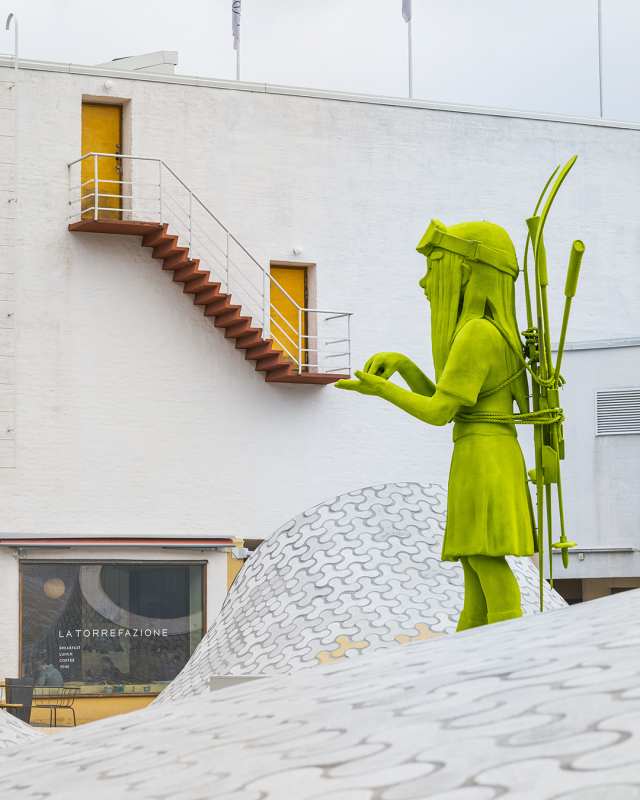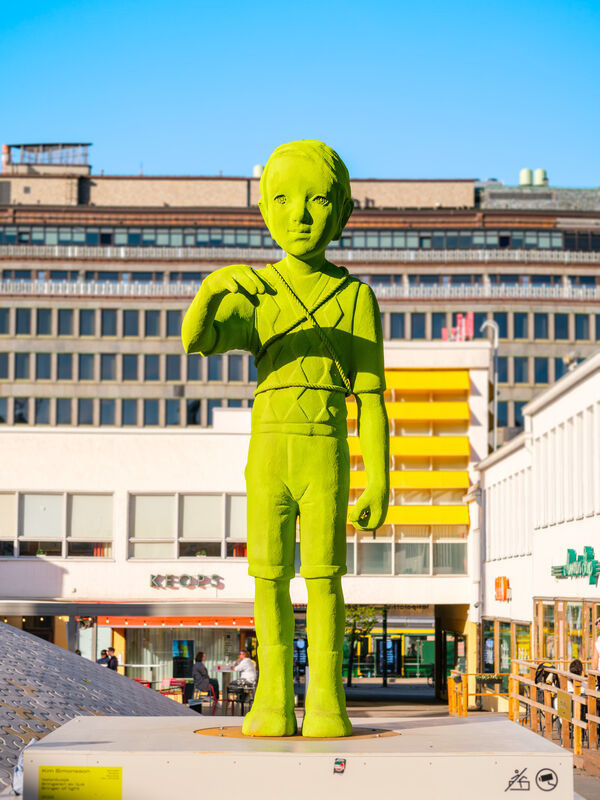
Kim Simonsson: Moss Giants 29.4 - 20.10.2024
Four huge, bright green figures have put down temporary roots in the Lasipalatsi square and Bio Rex terrace. The moss giants give off an air of mystery. Their origin is unknown: are they visitors from a parallel reality, or have they always been part of this world as we know it?
"The moss children are independent, and don't need the help of adults," Simonsson says. The children form a community, a band of travelers. Each child has been given its own specific task, all equally significant for maintaining their sense of community. Some carry tools and transport equipment on their backs, others are accompanied by animals, hinting at a close relationship with the natural and non-human world. Sign language allows them to communicate silently with one another and with their surroundings. Their presence reflects the artworks’ underlying idea of a utopian world where humans, animals and other beings co-exist peacefully. Perhaps the moss giants could be understood as monuments of wonder, or guides to a more fantastical view of the world. Rather than proclaiming truths, they invite us to question, dream and imagine in the same fearless way that children do. "It is important to give space to ideas that at first glance seem absurd," Simonsson explains.
The moss giants continue their journey in the autumn of 2024, when they head to Söderlångvik manor, Amos Anderson's summer residency on the island of Kimito. The sculptures will be installed in the woods next to the manor, where they will gradually become part of the forest ecosystem. As the sculptures have been acquired by the art collection of Föreningen Konstsamfundet, these woods will become a permanent home for the giants.
The sculptor Kim Simonsson (b. 1974) lives and works in the artists' village of Fiskars on the Southwest coast of Finland, and has been working with ceramic moss figures for almost a decade. The moss giants are among the artist's most large-scale works to date. They were originally created for the cultural festival lille3000, held in the French city of Lille during the year 2022. Simonsson's sculptures have previously been exhibited at the Amos Anderson Art Museum, but this is the first time the artist's work is shown outdoors in the centre of Helsinki. The exhibition is curated by Kai Kartio.
Please do not climb on the giants or their pedestals.
Kim Simonsson
![]()
Photo: Jefunne Gimpel
The sculptor Kim Simonsson (born 1974, Espoo) lives and works in the artist village of Fiskars on the Southwest coast of Finland. He is known for his unprejudiced storytelling and strong knowledge of materials. Simonsson works primarily with clay, often combining casting and hand-building techniques to craft animals and human figures. By adding handblown glass, fiber or everyday objects to his ceramic figures, the artist skillfully weaves tales characterized by strange, dream-like states.
Simonsson's artistic practice saw its beginnings in the 1990s, when he started his studies at the Department of Ceramics and Glass Design at the University of Applied Arts in Helsinki. Having long concentrated on drawing and painting, Simonsson soon came to embrace three-dimensional ways of working. Clay, a material that is sensitive to the touch of the hand, was well suited to Simonsson's artistic expression, which drew influences from the visual storytelling of comic art and Japanese anime. During his studies, Simonsson created life-size porcelain dogs, fearless children and other figures. These early works were an exception to the strong abstract expression that dominated the Finnish ceramics scene until the turn of the 21st century.
Simonsson has been experimenting with the so-called flocking technique since the 2010s. Flocking is used to apply coloured nylon fiber to different surfaces. Simonsson learned the technique during an artist residency in Canada and continued his flocking-tests once back in his studio in Fiskars. The velvet-like texture that characterizes the moss giants was the result of a lucky coincidence, when the artist happened to apply neon-yellow fibers to a throwaway piece of sculpture painted black. Simonsson quickly associated the iridescent green, mossy texture with the mystery of the deep forests and its beings. The chance experiment laid the foundation for the moss giant and other mossy figures, often depicting children.
Themes of childhood have preoccupied the artist since the beginning of his career. His child figures hover on the border between innocence and rowdiness, often challenging cultural norms about desirable and inappropriate behaviour. The artist calls them anarchist children. Today, Simonsson's artistic work is also influenced by his own experience of being a parent of two. The moss giants currently on display in the surroundings of Amos Rex are a case in point. Simonsson uses sign language to communicate with one of his children and this experience of learning a new language has become part of the giants’ unique world. In this way, Simonsson’s artistic work evolves in constant dialog with the trials and joys of everyday life.
Artworks
![]()
Kim Simonsson, Collector, 2022. Photo: Mika Huisman / Amos Rex
Collector
2022
Iron frame, polystyrene, fibreglass, nylon fibre, paint
(3,64 x 1,7 x 2 m)
Standing on the Bio Rex terrace, a giant observes the traffic junction below with alert eyes, perhaps searching for something worth collecting. The giant's hands give a gentle impression, as if they were cupped around an invisible object. This is the sign for collecting. As part of his artistic process, the artist Kim Simonsson uses objects found in his studio to design individual outfits for each individual giant. This intuitive way of working is evident in the collector’s equipment, which consists of a mishmash of different utensils and organic natural elements. What is worth collecting and saving for the future, and who gets to decide? In an ever-changing world, the previously useless can suddenly become an absolute necessity.
You can see the giant from the street level on the Mannerheimintie side.
![]()
Kim Simonsson, Wanderer, 2022. Photo: Mika Huisman / Amos Rex
Wanderer
2022
Iron frame, polystyrene, fibreglass, nylon fibre, paint
(4,16 x 1,24 x 2,08 m)
A wanderer with skis and poles has landed in the Lasipalatsi hills, ready to chart unknown territories. The giant hands declare a mission - two fingers moving across the palm is the sign for walking, or hiking. As sign language is largely based on movement, its expressive power is directly linked to the body and to touch. Humans gain an understanding of the world largely through our sense of touch. Another way to explore the world is through travel. But travelling doesn’t always entail moving from one far-flung place to another. It can also be an act of introspection, digging deep into our memories and moving across interior landscapes.
![]()
Kim Simonsson, Bringer of light, 2022. Photo: Mika Huisman / Amos Rex
Bringer of light
2022
Iron frame, polystyrene, fibreglass, nylon fibre, paint
(4,22 x 1,5 x 1,68 m)
Whoever enters the Lasipalatsi Ssquare from the direction of Simonkatu is greeted by a giant carrying a lamp on his back. The mass-produced desk light and the shorts and vest of the figure are strikingly ordinary compared to this otherwise fantastical being. The giant stretches out an open palm facing down, fingers spread wide. This is the sign for lamp and light, but also for the very moment when a light is switched on. Like children, light is often seen as a symbol of hope, pointing towards the possibility for a brighter future. Perhaps it’s also the task of the light bringer to shine a light on things that feel difficult to deal with. How do you feel about the future?
![]()
Kim Simonsson, Friendship, 2022. Photo: Mika Huisman / Amos Rex
Friendship
2022
Iron frame, polystyrene, fibreglass, nylon fibre, paint
(3,04 x 2,14 x 2,06 m)
This giant is peacefully seated next to the clock tower in the middle of the Lasipalatsi Ssquare. Like an attentive listener, the giant leans gently forward with an enigmatic smile. A frog and a squirrel have found their way into the open palms of the giant sitting cross-legged. A first glance would suggest a harmonious co-existence between the three creatures, yet the nature of their relationship is unclear. The sculpture invites us to reflect on the conditions under which friendship can arise and between whom. What does friendship mean to you?
Sign language
Sign languages are visual languages used by deaf, hard of hearing and hearing people. They consist of different signs, combining facial expressions, hand, body and mouth movements. Sign languages are characterized by a certain silence. They can be seen as evidence of the rich ways of communication that do not rely on hearing.
There are an estimated 160 different sign languages in the world. Each sign language has its own rhythm, and they may vary significantly. Sign languages have different dialects and slang expressions, and someone's way of signing might also be influenced by their age and where they live. However, sign languages share a strong visual quality that allows users to communicate fluently across national borders.
The two sign languages used in Finland are the Finnish-Swedish and Finnish sign language, which is also used by Kim Simonsson's moss giants. Read more about the giants' signs in the artwork descriptions!






